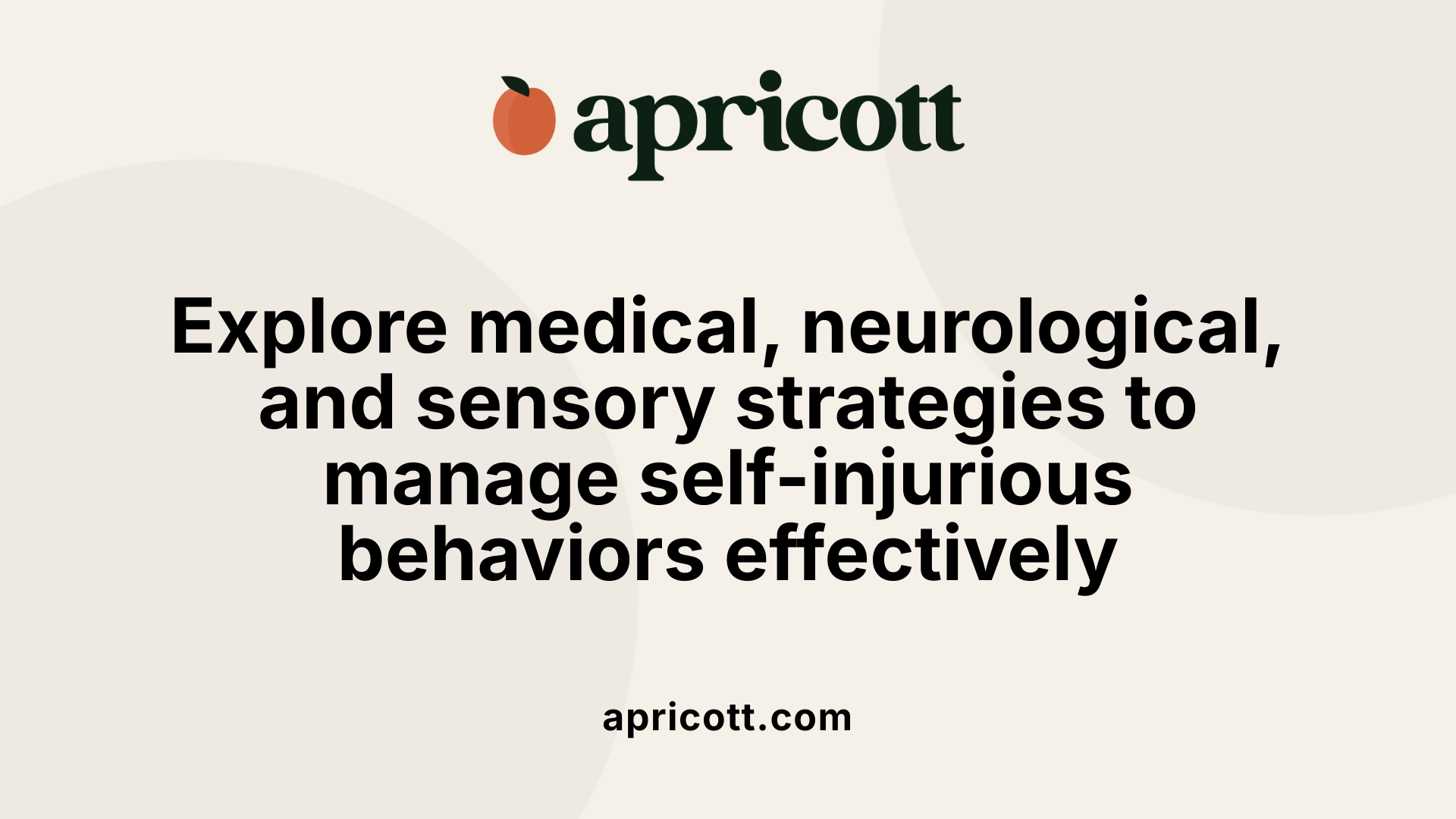Introduction to Self-Injurious Behaviors in Autism
Self-injurious behaviors such as head-banging present complex challenges within the autism spectrum, particularly among individuals with additional intellectual disabilities. These behaviors are influenced by a range of factors including communication difficulties, environmental triggers, and underlying medical or sensory needs. This article explores the nature of head-banging in autism, the behavioral therapy techniques employed to address it, and strategies for families and professionals to support individuals safely and effectively.
What Is Behavioral Therapy and Its Role in Treating Autism?

What is behavioral therapy and how is it used to treat autism?
Behavioral therapy refers to a scientifically supported method of improving specific behaviors, particularly for individuals with autism spectrum disorder (ASD). The most widely recognized form in autism treatment is Applied Behavior Analysis (ABA). ABA systematically assesses behavior patterns and uses reinforcement techniques to promote desirable skills like communication, social interaction, and daily living activities.
Principles of Behavioral Therapy in Autism
ABA breaks down complex behaviors into smaller, manageable steps, employing prompting and positive reinforcement to encourage progress. This approach focuses on increasing independence and reducing problem behaviors by identifying what motivates a child and rewarding appropriate behaviors.
Specialized Techniques: Pivotal Response Treatment (PRT) and Early Start Denver Model (ESDM)
- Pivotal Response Treatment (PRT): This naturalistic approach targets pivotal areas such as motivation and response to multiple cues to produce widespread improvement.
- Early Start Denver Model (ESDM): Designed for very young children, it blends ABA principles with developmental and relationship-based approaches using play and interaction.
Role of Caregivers and Professionals
Family involvement is crucial. Caregivers are trained to reinforce skills consistently across home environments. Professional oversight ensures individualized program design, assessment, and adjustment based on progress.
Importance of Early Intervention
Starting therapy early—ideally before age three—leverages the natural brain plasticity of young children. Early intervention significantly boosts outcomes in social communication and adaptive skills over time.
This combination of structured behavior modification and naturalistic teaching methods forms the foundation of effective behavioral therapy for autism, promoting meaningful and lasting improvements.
Recognizing Self-Injurious Behaviors in Autism: Focus on Head-Banging

What Are Common Types of Self-Injurious Behaviors (SIB)?
Individuals with autism spectrum disorder (ASD) may engage in various self-injurious behaviors. One of the most recognized forms is head-banging, where an individual repeatedly hits their head against a surface. Other examples include punching themselves, skin picking, and swallowing dangerous objects. These behaviors can cause significant harm and require careful management.
How Common Are SIBs in Autism Spectrum Disorder?
SIBs are not very common in the general population but occur more frequently in people with ASD, especially those who also have intellectual disabilities or limited ability to communicate effectively. The presence of additional intellectual challenges seems to increase the likelihood of these behaviors arising.
What Medical and Genetic Factors May Contribute to SIB?
Some medical issues can trigger or worsen self-injurious behaviors. For example, pain or involuntary movements related to seizures may be factors. Moreover, genetic conditions such as Lesch-Nyhan syndrome or Fragile X syndrome have been linked to a higher risk of SIB. Medical evaluation is crucial to rule out or address such causes.
How Do Emotional and Sensory Regulation Needs Play a Role?
Individuals might engage in SIB as a way to regulate sensory input or emotional states. For instance, head-banging can provide sensory stimulation or serve as a coping mechanism for overwhelming feelings. Understanding these sensory or emotional needs is important for effective intervention.
Can Communication Deficits Lead to SIB?
Yes, difficulties in communication are a significant contributor. When individuals cannot express needs, desires, or discomfort in functional ways, they may resort to behaviors like head-banging out of frustration. Addressing these communication challenges through teaching appropriate skills is critical in reducing SIB.
Understanding the Causes and Functions of Head-Banging

Why is Medical Evaluation Important?
Medical evaluation is a crucial first step when addressing head-banging in individuals with autism spectrum disorder (ASD). New, sudden, or constant self-injurious behavior (SIB) may be linked to medical issues like pain or involuntary movements such as seizures. Ruling out these causes helps ensure appropriate treatment and safety.
What is a Functional Behavioral Assessment (FBA)?
An experienced behavioral therapist conducts a Functional Behavioral Assessment to identify why head-banging occurs. This assessment pinpoints the specific triggers and purposes (functions) of the behavior, allowing for tailored interventions based on these findings.
What are the Four Functions Reinforcing SIB?
SIB, including head-banging, is maintained by four main functions:
- Attention: The behavior gains social interaction, even if negative.
- Escape or Avoidance: The individual uses SIB to avoid non-preferred tasks or situations.
- Access to Tangibles: SIB results in obtaining desired objects or activities.
- Sensory Stimulation: The behavior provides internal sensory feedback or relief.
Understanding these functions is vital for designing effective treatment plans.
How Do Environmental Triggers Influence Head-Banging?
Environmental factors can unintentionally reinforce head-banging. For example, if a child receives attention immediately after hitting their head, even if the attention is corrective, the behavior may increase. Recognizing and modifying these triggers can minimize SIB occurrences.
What is the Role of Genetic Syndromes?
Certain genetic syndromes like Lesch-Nyhan and Fragile X increase the likelihood of SIB. These conditions may cause neurological or metabolic imbalances, contributing to behaviors such as head-banging, thus requiring specialized evaluation and intervention.
How Do Communication Deficits and Emotional Regulation Affect SIB?
Many individuals with limited functional communication may resort to head-banging out of frustration or difficulty expressing needs and emotions. Moreover, challenges in emotional regulation can cause increased stress leading to SIB as a coping mechanism.
Addressing these underlying communication and emotional needs is essential for reducing head-banging behaviors in those with ASD.
Who Provides Behavioral Therapy Services for Autism?
Who provides behavioral therapy services for individuals with autism?
Behavioral therapy services for individuals with autism are delivered by a range of qualified professionals. This includes Board-Certified Behavior Analysts (BCBAs), behavior therapists, and licensed clinicians who specialize in autism treatment. These experts develop individualized treatment plans that address the unique needs of each child or adult, often based on thorough assessments like Functional Behavioral Assessments (FBAs).
Complementary professionals such as speech-language pathologists and occupational therapists also play vital roles. Speech therapists focus on enhancing communication skills—including teaching alternatives to self-injurious behaviors through Functional Communication Training (FCT)—while occupational therapists assist with sensory integration and daily living skills. Physical therapists may also be involved to support motor development.
Behavioral therapy takes place in diverse settings to best suit the individual’s needs. These include in-home sessions, schools, specialized therapy centers, and teletherapy options that provide access regardless of location. Family involvement is crucial across all settings, ensuring the strategies and interventions are consistently supported and reinforced at home and in the community.
Coordination among providers helps create a comprehensive treatment plan that evolves with the individual's progress. This collaborative approach promotes communication, independence, and social integration through evidence-based and personalized therapies.
Functional Communication Training: A Key Intervention for Reducing Head-Banging
What is Functional Communication Training (FCT)?
Functional Communication Training (FCT) is an evidence-based behavioral intervention developed in the 1980s that reduces self-injurious behaviors (SIB) like head-banging by teaching individuals to use appropriate communication instead. The core principle is replacing harmful behaviors with functional communicative responses that serve the same purpose, whether to gain attention, avoid tasks, or fulfill sensory needs.
How is FCT Implemented?
FCT involves several steps to ensure success:
- Functional Behavioral Assessment (FBA): First, a detailed assessment identifies the function or cause of the head-banging behavior.
- Selecting Communication Modalities: This could be verbal language, sign language, Picture Exchange Communication System (PECS), or other methods suited to the individual's abilities.
- Teaching Communication Responses: The individual is prompted to use the new communication methods in specific teaching situations.
- Prompt Fading: Gradually, prompts are reduced to encourage independent use.
- Generalization: Skills are generalized across different environments and situations to maintain effectiveness.
How Does FCT Replace Head-Banging?
For example, if a child's head-banging is a way to escape difficult tasks, FCT teaches them to use a simple, appropriate phrase or a card to request a break instead. This replacement holds the same function—escaping the task—while being safe and socially acceptable.
Role in Addressing Communication Deficits
Many individuals who engage in SIB struggle with communication. FCT directly tackles these deficits by providing functional communication tools, reducing frustration and the need to resort to harmful behaviors.
What Does Evidence Say About FCT?
Numerous studies confirm FCT’s effectiveness in significantly reducing SIB and improving communication skills in individuals with autism and intellectual disabilities. It is widely regarded as a compassionate and naturalistic approach, promoting safety and empathy.
By carefully analyzing behavior and teaching tailored communication strategies, FCT offers a practical and humane path to reducing head-banging and related behaviors in autism spectrum disorder.
Behavioral Strategies and Safety Measures to Manage Head-Banging

What is response blocking and how is it used?
Response blocking is a physical intervention where a trained professional safely interrupts dangerous behaviors, such as head-banging, to prevent injury. It involves gently stopping the action as soon as it begins, aiming to reduce harm and teach safer alternatives.
How do DRO and DRA techniques help reduce head-banging?
- Differential Reinforcement of Other Behavior (DRO): Reinforces the absence of head-banging during specified intervals, encouraging the individual to engage in other activities.
- Differential Reinforcement of Alternative Behavior (DRA): Reinforces specific alternative behaviors that serve the same function as head-banging, promoting appropriate ways to communicate needs or cope.
Why is immediate interruption and redirection important?
Promptly interrupting head-banging and guiding the individual toward safer behaviors helps prevent injury and reinforces positive responses. This approach works best when aligned with the function of the behavior, such as teaching communication for escape or attention.
How can environmental modifications support management?
Adjusting the surroundings to reduce triggers or providing preferred activities can minimize the motivation for head-banging. Examples include creating low-stimulation spaces or offering sensory tools.
When might protective gear or restraints be necessary?
If head-banging persists despite interventions and poses immediate harm, protective helmets or soft restraints may be used under professional supervision. These are safety measures, not long-term solutions.
What is the role of ongoing assessment and consistent intervention?
Regular functional behavioral assessments guide intervention adjustments. Consistent application of strategies across settings ensures effectiveness and helps generalize safer behaviors.
Why emphasize compassionate, naturalistic, ABA-based approaches?
Focusing on empathy and understanding fosters trust and cooperation. Using Applied Behavior Analysis (ABA) within natural environments promotes meaningful skill development while ensuring safety and respect for the individual.
Medical and Complementary Approaches in Managing Self-Injurious Behaviors

Medical Evaluations to Rule Out Pain or Seizures
A thorough medical evaluation is essential for individuals exhibiting self-injurious behaviors (SIB), especially when such behaviors are new or sudden. This helps identify underlying medical issues, such as pain or involuntary movements like seizures, that may be triggering the behavior.
Genetic Conditions Influencing SIB
Certain genetic disorders, including Lesch-Nyhan and Fragile X syndromes, increase the likelihood of SIB. Awareness of these conditions assists clinicians in tailoring appropriate interventions.
Medication Use: Risks and Benefits
In some cases, medications like Risperdal are prescribed to manage SIB. However, these treatments come with potential risks, making it vital for healthcare providers and families to carefully weigh the benefits against possible side effects before proceeding.
Role of Occupational Therapy and Sensory Integration
Occupational therapy often plays a complementary role by addressing sensory processing differences. Sensory integration techniques can help regulate sensory input that may provoke self-injury, offering children more adaptive ways to manage their sensory environment.
Addressing Sensory and Emotional Regulation
SIB can stem from difficulties in emotional and sensory regulation. Behavioral strategies combined with medical and therapeutic support aim to provide alternative coping mechanisms, reducing the need for self-harm as a form of self-stimulation or emotional outlet.
Integrating Medical and Behavioral Treatments
Optimal management of SIB involves a multidisciplinary approach. Medical intervention to treat underlying conditions, paired with behavioral therapies like Functional Communication Training (FCT), creates a cohesive plan that targets both the biological and behavioral aspects of self-injury, improving safety and quality of life.
| Aspect | Description | Role in Managing SIB |
|---|---|---|
| Medical Evaluation | Identifies pain, seizures, or medical causes | Foundation for tailored treatment |
| Genetic Conditions | Lesch-Nyhan, Fragile X syndromes affecting behavior | Guides specialized care |
| Medication | Risperdal and others with careful risk assessment | May reduce SIB when combined with therapy |
| Occupational Therapy | Sensory integration, adaptive strategies | Helps regulate sensory inputs and responses |
| Emotional Regulation | Behavioral support for emotional coping | Provides safer alternatives to self-injury |
| Integrated Approach | Combines medical and behavioral treatments | Comprehensive management of SIB |
The Importance of an Individualized and Empathetic Approach in Therapy
Tailoring Treatment Plans to Individual Causes and Needs
Each individual with autism and head-banging behaviors requires a unique treatment strategy. Behavioral interventions must be based on a thorough understanding of the specific causes and functions of the behavior, often determined through Functional Behavioral Assessments (FBA). Such detailed analysis ensures that therapies address underlying reasons—be it attention seeking, escape from demands, sensory needs, or communication difficulties—rather than just the symptoms.
Involving Families and Multidisciplinary Teams
Effective therapy involves collaboration among families, behavioral therapists, medical professionals, and educators. Families provide crucial insights about the individual's behavior across environments, while multidisciplinary teams contribute diverse expertise to develop comprehensive, effective plans.
Balancing Safety, Understanding, and Empowerment
Safety is paramount when managing head-banging, but interventions should also respect the individual's dignity. Using techniques like response blocking and protective equipment can prevent harm, but fostering understanding and empowerment through functional communication training (FCT) helps replace self-injury with appropriate communication, enhancing autonomy.
Importance of Early and Consistent Intervention Across Settings
Starting interventions early and maintaining consistency across home, school, and community settings maximize gains. Generalizing learned skills and behaviors boosts independence and reduces reliance on self-injury.
Promoting Communication and Independence
Teaching alternative communication methods—such as sign language or Picture Exchange Communication Systems (PECS)—reduces frustration that may trigger self-injury. Empowering individuals to express needs effectively decreases behaviors like head-banging and increases independence.
Enhancing Quality of Life for Individuals with Autism Exhibiting Head-Banging
By combining behavioral analysis with compassionate, individualized care, therapy improves not only behavioral outcomes but also social engagement and emotional well-being. This comprehensive approach supports a higher quality of life for those affected and their families.
What are the key benefits of using behavioral analysis in autism therapy?
Behavioral analysis, especially Applied Behavior Analysis (ABA), offers a scientifically validated method to understand and modify behaviors in autism. It pinpoints environmental factors influencing behaviors and uses positive reinforcement to encourage useful skills such as communication, social interaction, and daily living activities. Early, intensive ABA has shown to improve language, attention, and social skills significantly, promoting greater independence and enhancing overall quality of life for individuals with autism.
Conclusion: Compassionate Care for Head-Banging in Autism
Managing head-banging behaviors in individuals with autism requires a comprehensive understanding of the underlying causes, careful assessment, and tailored interventions. Behavioral therapies such as ABA and Functional Communication Training, combined with medical evaluation and safety strategies, provide a scientific and compassionate framework to reduce self-injury and promote essential communication skills. With dedicated professionals, family involvement, and empathetic approaches, those affected can achieve improved quality of life, greater independence, and safer daily experiences.
References
- Using Functional Communication Training to Reduce Self ...
- Self-Injurious Behavior | CHOP Research Institute
- How to Manage and Prevent Self Injurious Behavior In ...
- Applied Behavior Analysis (ABA)
- Applied Behavior Analysis (ABA)
- 6 Benefits of ABA Therapy for Children with Autism
- Behavioral Therapy for Autism Spectrum Disorder in ...
- Applied Behavior Analysis (ABA)
- Behavioral Management Therapy for Autism
- Autism Therapy Types & Interventions
.svg)
.svg)








